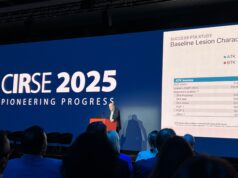
This year’s Vascular Interventional Advances annual meeting (VIVA 2020; 6–8 November, online) opened with a session on controversial hot topics and advanced multidisciplinary approaches to vascular disease. Looking back on the paclitaxel “debacle”, Peter Schneider (University of California San Francisco, San Francisco, USA) detailed key learnings from the last year and a half, pointed to forthcoming data that will help add further clarity, and praised the combined and ongoing efforts of researchers, societies, and regulatory bodies.
Schneider began by stressing the patency of paclitaxel in the femoropopliteal segment. At 12 months, the four randomised controlled trials (RCTs) of paclitaxel drug-coated balloons (DCBs) and drug-eluting stents (DESs) versus percutaneous transluminal angioplasty (PTA) that are currently approved in the USA—ILLUMENATE, IN.PACT SFA, Zilver PTX, and LEVANT—show a “significant improvement” in patency with DCB/DES use compared to PTA, he noted. Speaking to Interventional News, Schneider noted that, since then, the Eluvia DES and the Ranger DCB (both Boston Scientific), have also shown “excellent” results and been approved by the US Food and Drug Administration (FDA).
In December 2018, a meta-analysis of summary-level data was published, “which we all know about,” remarked Schneider, that suggested an increased risk of death with paclitaxel use in the femoropopliteal segment at two and five years. Here Schneider was referencing the 2018 Journal of the American Heart Association (JAHA) paper by Konstantinos Katsanos (University of Patras, Patras, Greece) and colleagues.
Highlighting the instant and enduring impact of this publication, Schneider commented: “Overnight, the use of paclitaxel-delivering devices diminished substantially, which means that overnight the value of our field diminished substantially, because now it takes so many more repeat revascularisations in order to keep our patients whole and to keep these arteries open.”
The meta-analysis relied upon three RCTs—Zilver PTX, THUNDER, and IN.PACT SFA—that were followed up to four or five years and encompassed “a little over 800 patients,” Schneider remarked. Delving into the characteristics of the trials included, he noted that they were all powered for one-year patency, not long-term mortality, and that small control groups were used, leading to “unstable estimates”.
Key learnings: No dose effect, no clustering of deaths as to cause, and “substantial geographic variation” in mortality signal
As the meta-analysis pointed to causality between paclitaxel and mortality, Schneider stressed that it was necessary to assess whether or not there was a dose response. In the meta-analysis, dose was calculated as dose multiplied by time. Supposing a continuous, linear, and increasing exposure to paclitaxel over time is “quite an assumption,” said Schneider, detailing that tissue paclitaxel in pre-clinical models decreased over six months to nearly non-detectable levels and that time is disproportionately available for studies with longer-term follow-up.
When the FDA looked at dose response on mortality, Schneider recalled that “they found none,” specifying that the FDA included the LEVANT II, Zilver PTX, ILLUMENATE, and IN.PACT IDE trials in their assessment. Similarly, there was no dose relationship found in either the IN.PACT investigational device exemption (IDE) and Japan trials, or in the VIVA/North American Science Associates (NAMSA) individual patient data project, Schneider added.
The presenter stated that, along with dose response, it was also crucial to assess whether there was a clustering of deaths, as this would suggest a biological mechanism.
In the FDA analysis, Schneider relayed, there was no clustering of deaths. He elaborated: “There was an increase in deaths in the patients that had paclitaxel, but these were spread across numerous causes, really questioning the availability of a biological mechanism”. This led the FDA to issue a letter on 7 August 2019, stating that there was “no clear evidence of a paclitaxel dose effect on mortality, and no identified pathophysiologic mechanism for the late deaths”.
“We know that these trials were powered for one-year patency, so what about the five-year mortality?” Schneider wondered, stressing that many of the paclitaxel RCTs had a considerable number of patients lost to follow-up or who had withdrawn by this time point.
Through a “Herculean effort” by both the clinical sites and by the study sponsors, “a dramatic number” of these patients were identified, located, and their vital status ascertainment found, Schneider detailed. He noted that a five-year point estimate by the FDA developed a risk of 1.72, which after vital status ascertainment was 1.57, showing a decrease of 21%. The same happened in the IN.PACT IDE and Japan trials, he added, where the hazard ratio decreased by 38%, from 1.63 to 1.39 after vital status follow-up.
The third key point that Schneider addressed was the inconsistency of the mortality signal. In the IN.PACT SFA and the LEVANT II trials that were performed in both the USA and the European Union (EU), there was a “significant difference” in how the patients in the USA versus how those in the EU fared, with no apparent difference in mortality outside the USA, Schneider explained. “Why would this agent be more dangerous in one geography than another?” he asked.
“DCB and PTA patients are treated differently,” Schneider observed, adding that the difference in treatment is greater in the USA than in other geographies. Furthermore, he noted that the IN.PACT IDE and Japan trials, which were performed across different geographies using the same device, not only reveal this difference, but also show that PTA patients were more likely to follow up, with the biggest difference observed in the USA. “This really suggests that there may have been a treatment bias involved,” Schneider opined.
“When you include studies conducted outside the USA—ILLUMENATE EU, IN.PACT Japan, LEVANT I, and Lutonix Japan, for example—along with studies conducted on the same devices inside the USA—ILLUMENATE RCT, IN.PACT SFA, LEVANT II, and Zilver PTX—what you see is a significant drop in the hazard ratio,” he revealed.
Looking ahead: More data, continued collaboration, and trial design improvements
Summarising, Schneider noted that while paclitaxel is consistently efficacious, the mortality signal is not consistent. “There is no dose response and no biological mechanism, and the signal is not apparent so far in real-world data,” he communicated.
In addition, he told the VIVA audience that the signal is not consistent in the RCTs. The signal diminished with vital status ascertainment, and also when patients from outside the USA—where the signal was primarily observed—were included, he précised. “There is a possibility of treatment bias associated with trial design or practice patterns, which may help explain inconsistency of signal,” Schneider speculated.
The paclitaxel debacle is “crystalising,” the presenter concluded, pointing to an increasing volume of new data, with more to follow. Over the next five years, he revealed that 29 studies will yield randomised data on over 11,000 patients, including ILLUMENATE, IMPERIAL, TRANSCEND, VOYAGER, BEST, and SWEDEPAD.
Looking forward, Schneider pointed out that trial design improvements will be made with regards to the size, quality of follow-up, veracity of medical management, and vital status ascertainment.
Indeed, Schneider detailed how the VOYAGER trial sets an example for paclitaxel trials of the future. He commented: “One of the key things about VOYAGER, although it was not paclitaxel versus non-paclitaxel, is that it was a prospective randomised controlled trial in which they had excellent ascertainment, where they followed up more than 99% of the patients.” In addition, he mentioned that VOYAGER had “excellent control of medications”, which is “something that we did not do in the prospective randomised trials”.
At the end of his presentation, Schneider commended the continued collaboration of researchers, societies, manufacturers, and regulatory agencies “across specialties and countries” in the interest of moving things forward.
In relation to the role of the FDA specifically, an audience member asked what the agency has learned from the ongoing paclitaxel debate and how they will change things. “The FDA are in a challenging situation,” Schneider acknowledged. “Obviously they are there to protect the public health, but also to facilitate the ability for us to use the tools we need.”
He continued: “It is not clear to me what and how the FDA will use all the new information that is coming out, but there has been a massive amount of information. I did not go into the extensive amount of real-world data that we have but there is a tremendous amount, so I am sure the FDA is continually reconsidering this, but really the question is not the amount of data, but what is the threshold for them to act, for them to change the guidance that they gave us in August of 2019. Nobody knows that, and I do not know that they have even decided what that would look like.”
Schneider noted that the FDA has approved two paclitaxel devices since the paclitaxel situation began—the Ranger DCB from Boston Scientific and the IN.PACT AV Access balloon from Medtronic—which is “really the key”. He ended with the comment that “if [the FDA] felt there was a strong danger at this point, I do not believe they would approve new devices”.













